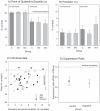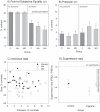Migraine increases centre-surround suppression for drifting visual stimuli
- PMID: 21494594
- PMCID: PMC3073931
- DOI: 10.1371/journal.pone.0018211
Migraine increases centre-surround suppression for drifting visual stimuli
Abstract
Background: The pathophysiology of migraine is incompletely understood, but evidence points to hyper-responsivity of cortical neurons being a key feature. The basis of hyper-responsiveness is not clear, with an excitability imbalance potentially arising from either reduced inhibition or increased excitation. In this study, we measure centre-surround contrast suppression in people with migraine as a perceptual analogue of the interplay between inhibition and excitation in cortical areas responsible for vision. We predicted that reduced inhibitory function in migraine would reduce perceptual surround suppression. Recent models of neuronal surround suppression incorporate excitatory feedback that drives surround inhibition. Consequently, an increase in excitation predicts an increase in perceptual surround suppression.
Methods and findings: Twenty-six people with migraine and twenty approximately age- and gender-matched non-headache controls participated. The perceived contrast of a central sinusoidal grating patch (4 c/deg stationary grating, or 2 c/deg drifting at 2 deg/sec, 40% contrast) was measured in the presence and absence of a 95% contrast annular grating (same orientation, spatial frequency, and drift rate). For the static grating, similar surround suppression strength was present in control and migraine groups with the presence of the surround resulting in the central patch appearing to be 72% and 65% of its true contrast for control and migraine groups respectively (t(44) = 0.81, p = 0.42). For the drifting stimulus, the migraine group showed significantly increased surround suppression (t(44) = 2.86, p<0.01), with perceived contrast being on average 53% of actual contrast for the migraine group and 68% for non-headache controls.
Conclusions: In between migraines, when asymptomatic, visual surround suppression for drifting stimuli is greater in individuals with migraine than in controls. The data provides evidence for a behaviourally measurable imbalance in inhibitory and excitatory visual processes in migraine and is incompatible with a simple model of reduced cortical inhibitory function within the visual system.
Conflict of interest statement
Figures




References
-
- Lipton RB, Bigal ME. The epidemiology of migraine. Am J Med. 2005;118:3S–10S. - PubMed
-
- Lipton RB, Scher AI, Kolodner K, Steiner TJ, Stewart WF. Migraine in the United States: epidemiology and patterns of health care use. Neurology. 2002;58:885–894. - PubMed
-
- Stovner LJ, Hagen K, Jensen R, Katsarava Z, Lipton RB, et al. The global burden of headache: a documentation of headache prevalence and disability worldwide. Cephalalgia. 2007;27:193–210. - PubMed
-
- The International Headache Society. The International Classification of Headache Disorders. Cephalalgia. 2004;24 - PubMed
-
- Shepherd AJ. Increased visual after-effects following pattern adaptation in migraine: a lack of intracortical excitation? Brain. 2001;124:2310–2318. - PubMed
Publication types
MeSH terms
LinkOut - more resources
Full Text Sources
Medical

